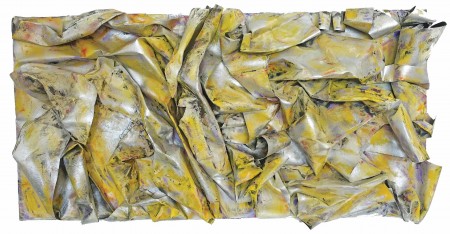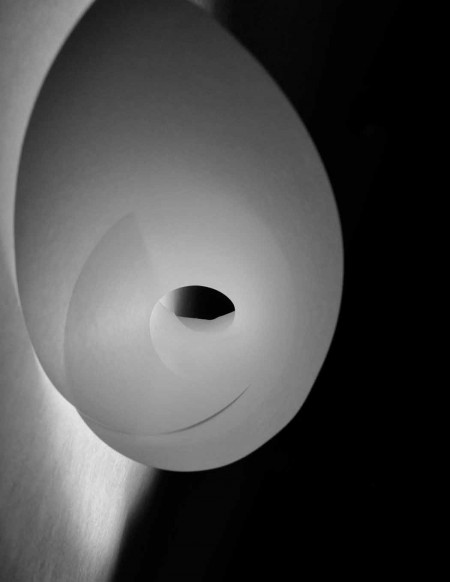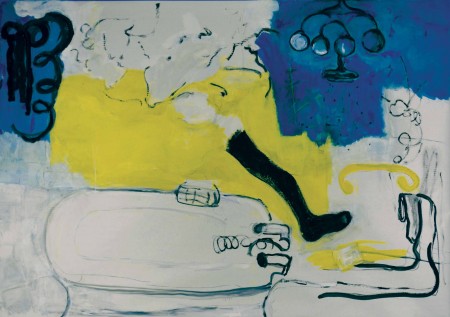Set in the foothills above the City of Glendale, Brand Library and Art Center has been serving music and art lovers across Southern California since 1956. Not only does its library offer more than 110,000 items dedicated exclusively to fine art and music, but its art galleries offer unique programming year-round, including a variety of exhibitions that feature works by both established and emerging artists.
September 24th marked another distinguished opening, the Art Center’s 44th juried exhibition, “Brand 44 Works on Paper,” organized and sponsored by the Brand Associates. Curated by the internationally recognized Los Angeles-based artist Laddie John Dill, the extensive exhibition features more than 100 works, selected from 823 submissions, showcasing a wide range of works on paper including collage, drawing, painting, photography, printmaking, watercolor and sculpture.
While the works on display are constructed of or on paper, it doesn’t focus on any one genre or theme. Rather, the show emphasizes how paper, as a material, can be utilized multifariously, as more than a canvas but as a tool for expression.
Sharon Barnes’ mixed media piece entitled Not Flat but Undulating through Time is just one of many pieces constructed from an unconventional paper product. Made from industrial roofing paper, Not Flat… assumes a sculptural quality which she achieved “through a process of cutting and tearing this heavy sheeting, then bending and shaping it.” Painted in hues of yellow and grey, the rectangular piece measuring 24” x 48” x 3” looks like a sheet of metal, crumpled and welded together like one of John Chamberlain’s assemblages constructed from old automobile parts.
Relic 1 by Jeff Iorillo is another absorbing work that draws viewers in to inspect its unusual concoction of constituents which together read like a broken fragment of tree bark measuring 46” x 40” x 3”. “By manipulating and layering archival materials,” Iorillo says that his aim is to “create works that present themselves as artifacts with a history.” His process is intensive. Not only does it involve the soaking, distressing, gluing and ripping of acid free archival cardboard and paper, but it also includes the application of wet clay, crushed marble, ink and beeswax, which he bakes with a blowtorch to give his work the appearance of an aged veneer, suggestive of the passage of time.
Elaine Langerman is another artist whose interest lies in the ways her materials coalesce. An exploration of “the effect of silverpoint on a black gesso ground [when] applied to fine, archival white paper,” Reflections #2 is the byproduct of Langerman’s fascination “with the sensual experience and tactile sensation of the actual drag of the silver point across the black surface with slight quality of bite.” Set within a rectangular outline, the 15” x 20” piece comprises an intricate mash-up of delicate lines depicting marine life and sea shells which, according to the artist, summon the many joyous seaside excursions she experienced as a child.
It comes as no surprise, given paper’s widespread use for documentation, that several works in the show integrate pages from books and other text based materials. Sandra Krause’s hanging sculpture Pillar, for one, is a whimsical amalgam of dangling conical shapes reminiscent of Ruth Asawa’s looped wire sculptures. Made from the pages of old discarded books which she methodically folded with scrupulous precision, Krause’s work is the physical manifestation of a “meditative process that” she says, “can be done anywhere, allowing productivity and calm in places and timeframes that are often transitional and fleeting.”
Other artists featured in this show who integrate textual documents into their work include Jade, Carole P. Kunstadt and Susan Melly, whose sculpture, The Singer, is a continuation of her ongoing exploration of the seamstresses of the WWII era and how their work impacted an industry largely governed by men. Draped in vintage dress patterns, the 21” tall sculpture appears as a traditional dress form. Constructed out of papier mache and crowned with a child’s antique Singer sewing machine, The Singer melds original sewing patterns with notions from a generation past in an attempt to instigate a discussion about the relationships that have and continue to exist between industrialization, female identity, and concepts of power.
Several photographs also appear in the show including those by Jim Newberry, Patrick Ramsey, Steven Stanger, Stephanie Sydney, and John VanDewerker to name only a few. Joy Curtis Urlik’s “Paper Series” is noteworthy in that the work itself is about photographing paper which she cuts into various shapes. “By physically creating environments constructed from plain paper,” Urlik creates “work that is suggestive of organic energies found within nature.” Paper Series #4, for example, brings to mind the image of a nautilus mollusk, the only living member of the subclass nautiloidea, commonly considered a living fossil whose shell is generally smooth yet characterized by a select few whorl depressions.
And then there are a handful of works that express what Barbara Kaleta emphasizes as “a wonderful way to get back to the unfettered place where we first made art as kindergarteners scribbling on newsprint.” The action of painting on paper rather than canvas is what Kaleta explains as a freedom to work with abandon. Less concerned with perfection and instead captivated by the urgency that the impulsive brushstroke can impart, Kaleta finds paper the perfect conduit for expression. Not only does she value paper for its aptitude for absorbing oils and turpentine, but she appreciates its capacity for relinquishing her initial sketch marks which ultimately are what add to her work’s playful zest and spirited sense of movement. In reference to “Downton Abbey,” Don’t Slip on the Soap doesn’t just warn us about our fascination with luxury, but its whimsical depiction of a decadent bathroom complete with a chandelier inspires us to acknowledge our own absurd absorptions with materialism.
Additional artists featured include Sharron Antholt, Alex Babajanyan, Barbara Blatt, Michelle Benzamin-Miki, Sandy Bleifer, Liza Hennessey Botkin, Nancy D. Brown, John A. Calabrese, Michael Chesler, Sapira Cheuk, Hyunsook Cho, Wonju Choi, Gianfranco Cioffi, Bonese Collins Turner, Marie Danielsson-Yung, Harach Davoodian, Lanny DeVuono, Michelle Lynn Dyrness, Zena Fairweather, Raymond Gaston, John Gauld, Ruth Gregory, Dirk Hagner, Susan Hannon, Shelley Heffler, Lyn Horton, Brenda Hurst, Marielle Jakobsons, Aron Kearney, Colleen M. Kelly, Katie Kline, Leslie Lanxinger, Warner LeMenager, Pamela Lewis, Cynthia Lujan, Sylvia Marcin, Randi Matuschevitz, Adele Mills, Melissa Mohammadi, Rea Nagel, Bob Nugent, Jennifer Park, Eric William Pierson, Rebecca Puga, Jeremy J. Quinn, Irena Raulinaitis, Melissa Reischman, Danelle Rivas, Alain Rogier, Bonnie Denver Ruttan, John Selleck, Katherine Shanks, Stephanie Sherwood, Mahara T. Sinclaire, Caryl St. Ama, Kathleen Thompson, Arella Tomlinson, Hedy Torres, Mike Usher, Mark Vallen, Dana L. Walker, Peter Walker, Graeme Whifler, Karen Winters, Suze Woolf and Jim Zver.
“Brand Forty-Four Works on Paper” will remain on view through October 28th at Brand Library and Art Center, located at 1601 West Mountain Street in Glendale, California.
–Anise Stevens









October 10th, 2016at 5:56 pm(#)
Anise – thank you so much for including me in your article. I am always amazed with your insight and share many of your thoughts on this exhibit. What a wonderful space and curation. What amazing work hanging from those walls – so much creativity and talent. I encourage everyone to visit this show and read this article. Susan